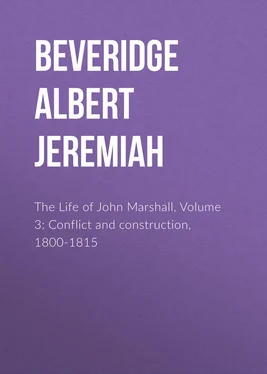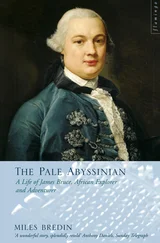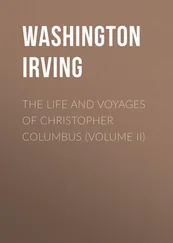Albert Beveridge - The Life of John Marshall, Volume 3 - Conflict and construction, 1800-1815
Здесь есть возможность читать онлайн «Albert Beveridge - The Life of John Marshall, Volume 3 - Conflict and construction, 1800-1815» — ознакомительный отрывок электронной книги совершенно бесплатно, а после прочтения отрывка купить полную версию. В некоторых случаях можно слушать аудио, скачать через торрент в формате fb2 и присутствует краткое содержание. Жанр: foreign_prose, foreign_antique, Биографии и Мемуары, foreign_language, на английском языке. Описание произведения, (предисловие) а так же отзывы посетителей доступны на портале библиотеки ЛибКат.
- Название:The Life of John Marshall, Volume 3: Conflict and construction, 1800-1815
- Автор:
- Жанр:
- Год:неизвестен
- ISBN:нет данных
- Рейтинг книги:4 / 5. Голосов: 1
-
Избранное:Добавить в избранное
- Отзывы:
-
Ваша оценка:
- 80
- 1
- 2
- 3
- 4
- 5
The Life of John Marshall, Volume 3: Conflict and construction, 1800-1815: краткое содержание, описание и аннотация
Предлагаем к чтению аннотацию, описание, краткое содержание или предисловие (зависит от того, что написал сам автор книги «The Life of John Marshall, Volume 3: Conflict and construction, 1800-1815»). Если вы не нашли необходимую информацию о книге — напишите в комментариях, мы постараемся отыскать её.
The Life of John Marshall, Volume 3: Conflict and construction, 1800-1815 — читать онлайн ознакомительный отрывок
Ниже представлен текст книги, разбитый по страницам. Система сохранения места последней прочитанной страницы, позволяет с удобством читать онлайн бесплатно книгу «The Life of John Marshall, Volume 3: Conflict and construction, 1800-1815», без необходимости каждый раз заново искать на чём Вы остановились. Поставьте закладку, и сможете в любой момент перейти на страницу, на которой закончили чтение.
Интервал:
Закладка:
When the Ellsworth Bill had become a law, Senator William Grayson of Virginia advised Patrick Henry that it "wears so monstrous an appearance that I think it will be felo-de-se in the execution… Whenever the Federal Judiciary comes into operation, … the pride of the states … will in the end procure its destruction" 159 159 Grayson to Henry, Sept. 29, 1789, Tyler, i, 170-71.
– a prediction that came near fulfillment and probably would have been realized but for the courage of John Marshall.
While Grayson's eager prophecy did not come to pass, the Judiciary Act of 1789 worked so badly that it was a source of discontent to bench, bar, and people. William R. Davie of North Carolina, a member of the Convention that framed the Constitution and one of the most eminent lawyers of his time, condemned the Ellsworth Act as "so defective … that … it would disgrace the composition of the meanest legislature of the States." 160 160 Davie to Iredell, Aug. 2, 1791, Life and Correspondence of James Iredell : McRee, ii, 335.
It was, as we have seen, 161 161 Vol. ii, 552-53, of this work.
because of the deficiencies of the original Judiciary Law that Jay refused reappointment as Chief Justice. "I left the bench," he wrote Adams, "perfectly convinced that under a system so defective it would not obtain the energy, weight, and dignity which are essential to its affording due support to the national government, nor acquire the public confidence and respect which, as the last resort of the justice of the nation, it should possess." 162 162 Jay to Adams, Jan. 2, 1801, Jay : Johnston, iv, 285.
The six Justices of the Supreme Court were required to hold circuit courts in pairs, together with the judge of the district in which the court was held. Each circuit was to be thus served twice every year, and the Supreme Court was to hold two sessions annually in Washington. 163 163 Annals , 1st Cong. 2d and 3d Sess. 2239.
So great were the distances between places where courts were held, so laborious, slow, and dangerous was all travel, 164 164 See vol. i, chap. vi, of this work. The conditions of travel are well illustrated by the experiences of six members of Congress, when journeying to Philadelphia in 1790. "Burke was shipwrecked off the Capes; Jackson and Mathews with great difficulty landed at Cape May and traveled one hundred and sixty miles in a wagon to the city; Burke got here in the same way. Gerry and Partridge were overset in the stage; the first had his head broke, … the other had his ribs sadly bruised… Tucker had a dreadful passage of sixteen days with perpetual storms." (Letter of William Smith, as quoted by Johnson: Union and Democracy , 105-06.) On his way to Washington from Amelia County in 1805, Senator Giles was thrown from a carriage, his leg fractured and his knee badly injured. (Anderson, 101.)
that the Justices – men of ripe age and studious habits – spent a large part of each year upon the road. 165 165 This arrangement proved to be so difficult and vexatious that in 1792 Congress corrected it to the extent of requiring only one Justice of the Supreme Court to hold circuit court with the District Judge; but this slight relief did not reach the serious shortcomings of the law. ( Annals , 2d Cong. 1st and 2d Sess. 1447.) See Adams: U.S. i, 274 et seq. , for good summary of the defects of the original Judiciary Act, and of the improvements made by the Federalist Law of 1801.
Sometimes a storm would delay them, and litigants with their assembled lawyers and witnesses would have to postpone the trial for another year or await, at the expense of time and money, the arrival of the belated Justices. 166 166 See statement of Ogden, Annals , 7th Cong. 1st Sess. 172; of Chipman, ib. 123; of Tracy, ib. 52; of Griswold, ib. 768; of Huger, ib. 672.
A graver defect of the act was that the Justices, sitting together as the Supreme Court, heard on appeal the same causes which they had decided on the Circuit Bench. Thus, in effect, they were trial and appellate judges in identical controversies. Moreover, by the rotation in riding circuits different judges frequently heard the same causes in their various stages, so that uniformity of practice, and even of decisions, was made impossible.
The admirable Judiciary Act, passed by the Federalists in 1801, corrected these defects. The membership of the Supreme Court was reduced to five after the next vacancy, the Justices were relieved of the heavy burden of holding circuit courts, and their duties were confined exclusively to the Supreme Bench. The country was divided into sixteen circuits, and the office of circuit judge was created for each of these. The Circuit Judge, sitting with the District Judge, was to hold circuit court, as the Justices of the Supreme Court had formerly done. Thus the prompt and regular sessions of the circuit courts were assured. The appeal from decisions rendered by the Supreme Court Justices, sitting as circuit judges, to the same men sitting as appellate judges, was done away with. 167 167 Of course, to some extent this evil still continued in the appeals to the Circuit Bench; but the ultimate appeal was before judges who had taken no part in the cause. The soundness of the Federalist Judiciary Act of 1801 was demonstrated almost a century later, in 1891-95, when Congress reënacted every essential feature of it. (See "Act to establish circuit courts of appeals and to define and regulate in certain cases the jurisdiction of the courts of the United States, and for other purposes," March 3, 1891, chap. 517, amended Feb. 18, 1895, chap. 96.)
In establishing these new circuits and creating these circuit judges, this excellent Federalist law gave Adams the opportunity to fill the offices thus created with stanch Federalist partisans. Indeed, this was one motive for the enactment of the law. The salaries of the new circuit judges, together with other necessary expenses of the remodeled system, amounted to more than fifty thousand dollars every year – a sum which the Republicans exaggerated in their appeals to the people and even in their arguments in Congress. 168 168 For example, Senator Cocke of Tennessee asserted the expense to be $137,000. ( Annals , 7th Cong. 1st. Sess. 30.) See especially Prof. Farrand's conclusive article in Am. Hist. Rev. v, 682-86.
Chiefly on the pretext of this alleged extravagance, but in reality to oust the newly appointed Federalist judges and intimidate the entire National Judiciary, the Republicans, led by Jefferson, determined to repeal the Federalist Judiciary Act of 1801, upon the faith in the passage of which John Marshall, with misgiving, had accepted the office of Chief Justice.
On January 6, 1802, Senator John Breckenridge of Kentucky pulled the lanyard that fired the opening gun. 169 169 It was to Breckenridge that Jefferson had entrusted the introduction of the Kentucky Resolutions of 1798 into the Legislature of that State. It was Breckenridge who had led the fight for them. At the time of the judiciary debate he was Jefferson's spokesman in the Senate; and later, at the President's earnest request, resigned as Senator to become Attorney-General.
He was the personification of anti-Nationalism and aggressive democracy. He moved the repeal of the Federalist National Judiciary Act of 1801. 170 170 Breckenridge's constituents insisted that the law be repealed, because they feared that the newly established National courts would conflict with the system of State courts which the Legislature of Kentucky had just established. (See Carpenter, Am. Pol. Sci. Rev. ix, 523.) Although the repeal had been determined upon by Jefferson almost immediately after his inauguration (see Jefferson to Stuart, April 8, 1801; Works : Ford, ix, 247), Breckenridge relied upon that most fruitful of Republican intellects, John Taylor "of Caroline," the originator of the Kentucky Resolutions (see vol. ii, 397, of this work) for his arguments. See Taylor to Breckenridge, Dec. 22, 1801, infra , Appendix B.
Every member of Senate and House – Republican and Federalist – was uplifted or depressed by the vital importance of the issue thus brought to a head; and in the debate which followed no words were too extreme to express their consciousness of the gravity of the occasion. 171 171 Annals , 7th Cong. 1st Sess. 31-46, 51-52, 58, 513, 530.
Интервал:
Закладка:
Похожие книги на «The Life of John Marshall, Volume 3: Conflict and construction, 1800-1815»
Представляем Вашему вниманию похожие книги на «The Life of John Marshall, Volume 3: Conflict and construction, 1800-1815» списком для выбора. Мы отобрали схожую по названию и смыслу литературу в надежде предоставить читателям больше вариантов отыскать новые, интересные, ещё непрочитанные произведения.
Обсуждение, отзывы о книге «The Life of John Marshall, Volume 3: Conflict and construction, 1800-1815» и просто собственные мнения читателей. Оставьте ваши комментарии, напишите, что Вы думаете о произведении, его смысле или главных героях. Укажите что конкретно понравилось, а что нет, и почему Вы так считаете.












